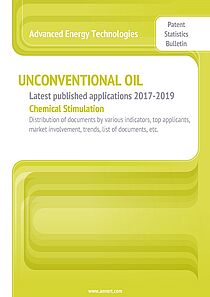UNCONVENTIONAL OIL. Latest published applications 2017-2019. Chemical Stimulation

Summary
Unconventional oil enhanced recovery (EOR) technologies can be generally divided into thermal and non-thermal. The latter are mostly represented by chemical stimulation methods, such as surfactant flooding, polymer flooding, alkali flooding, as well as combinations of these methods. The most frequently used chemical method is polymer flooding. Polymer solutions increase the viscosity of the displacing water and reduce the permeability of the porous media, hence improving the mobility ratio of a displacement process and the sweep efficiency of the reservoir. One of the promising EOR methods is the Vapor Assisted Petroleum Extraction (VAPEX) process that applies the injection of a vaporized hydrocarbon solvent in order to dilute the oil and decrease its viscosity. However, the relatively high costs of the chemicals involved, insufficient injection rate, high carbon dioxide emissions and utilization of unsafe waste from chemical stimulation have all emerged as challenges for non-thermal enhanced oil production. New approaches to chemical stimulation are aimed at addressing these challenges, thus achieving desirable production effects and economic benefits. The proposed patent statistical bulletin covers recent patent applications on this topic.
A selection of patent applications related to chemical stimulation in unconventional oil and published by patent offices around the globe in 2017-2019 is provided for review in the present bulletin. General research methodology can be found on the Advanced Energy Technologies website. The present bulletin includes 1970 patent applications, prepared by applicants from 27 countries and registered in 33 patent offices. The patent documents mention 368 applicants and 1081 IPC subgroups.
Key Highlights
The bulletin contains statistical data on the distribution of patent documents by years, by patent offices and by applicant countries, applicant-related data (residents and non-residents), data on the most frequently mentioned International Patent Classification divisions (sections, classes, subclasses, groups, and subgroups). The top three patent offices that registered the largest number of patent applications were CNIPA (China), USPTO (USA) and WIPO.
For each of the patent documents selected for the examination in the present bulletin the characteristics of unified indicators were preliminary defined, they include: technical problems, types of inventive solutions employed, belonging to one or other technological segment. This allows the internal content for each of the indicators in the aggregate array of documents to be visualized, for instance, to define the sequence and proportional correlation of technical problems the inventive solutions disclosed in the texts aim to solve. A list of the top 10 groups consisting of patent documents with identical unified indicators contains ID numbers and applicant names of respective documents; the groups are sorted by the number of patent documents.
The following information can be found for the top 10 applicants: breakdown of applications by problems, IPC sections, patent offices, technological indicators, as well as the estimation of their share in the established intellectual property market. The 10 leading applicants by the number of patent documents were: Baker Hughes Incorporated (US), China Petroleum & Chemical Company (CN), Ecolab (US), Saudi Arabian Oil Company (SA), BASF, SE (DE), Sinopec SRIPT Shanghai Research Institute of Petrochemical Technology (CN), Locus Oil Ip Company LLC (US), Chevron USA, Inc. (US), Dow Global Technologies (US), and Kemira Oyj (FI).
The bulletin contains lists of the top 10 prominent documents having the highest bibliographical rating, the most extensive coverage of IPC sections, and those not being part a of patent family.
The conclusive part of the bulletin represents the lists of all of the documents reviewed, arranged by the top 10 groups of patent documents with identical unified indicators and by patent offices with the indication of the ID numbers of the registered patent applications.
Who needs this bulletin?
The proposed patent statistics bulletin allows the existing trends in the intellectual property market of the specified industrial sector to be timely traced, as well as the possibility of acquiring a carefully selected list of patent documents fully corresponding to the specified subject. The bulletin can be useful for inventors, engineers, scientific workers, and business representatives, who are focused on the development of unconventional oil production technologies.


